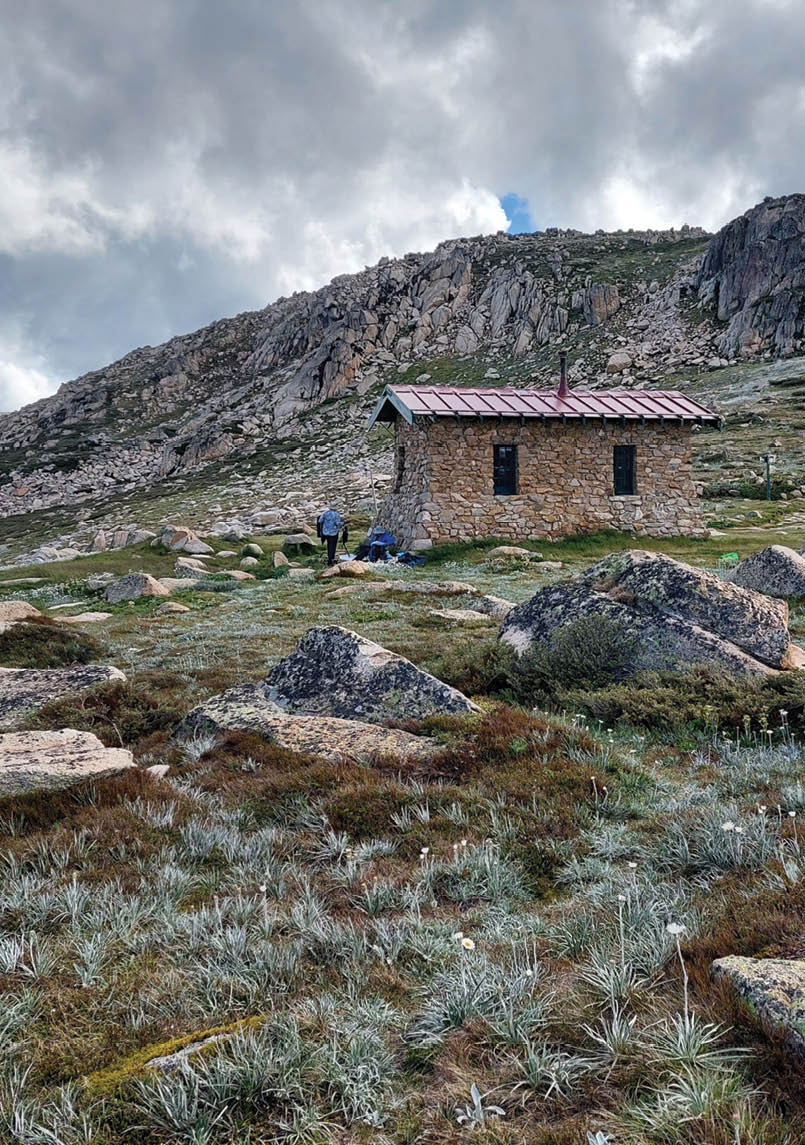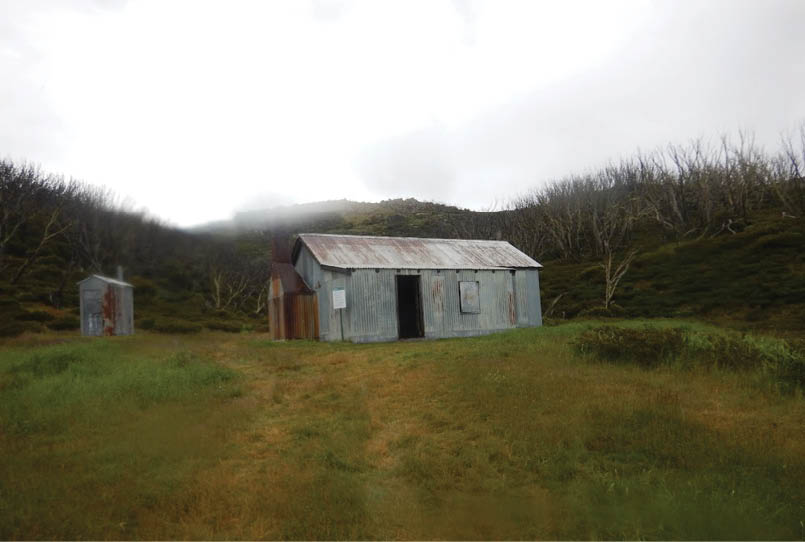




Did you know there are around 200 huts in the Australian Alpine region and do you know what hut etiquette is? Well, keep reading if you are interested in learning a few basic facts about the huts of the high country.
Seamans Hut, Kosciuszko NP, NSWSonya Muhlsimmer
Huts of the High Country and Hut Etiquette
Sonya Muhlsimmer
46 | BWA February 2022


Recently I took a few experienced and novice hikers down to Kosciuszko National Park for a three-day hike. I took them to see and experience some backcountry huts like Horse Camp and Whites River Huts and along the Main Range to Seamans Hut and a short way from there to view Cootapatamba Hut.
Before we get onto the huts of the first explorers, I want to acknowledge and pay my respects to the traditional custodians on their traditional land of the Monaro-Ngarigo people on which we work, live and play and we give respect to their Elders past, present and emerging.
In the high country there has been some evidence found as high as Perisher Gap (around 1815 metres) of occupation and dwellings which may date back to 7000 years. However, there is still no information on how or where the huts were made. The thought is that rock shelters and dwellings were made out of sticks, bark and animal skins in an A-frame construction that could
have been utilised in conjunction with the annual migration of Bogong moths. Then the first explorers, squatters and stockmen came around 1830 that started constructing simple huts with bark or canvas roofs. By the 1930s, huts were more one-room structures with fireplaces and corrugated iron roofs.
There are three main classifications for huts: survival huts, recreational huts and historical and architectural huts. Before we go any further, the majority of the historic huts are only to be used for emergencies. There is so much history around Kosciuszko National Park and huts from the old days available and is worth a read. The late Klaus Hueneke has written an excellent book called Huts of the High Country if you are interested in the history and range of huts spread out over the landscape. His in-depth knowledge of the history of the huts is astounding. This is where I have collated some of my information from. Klaus was a long-time member and former president of the Kosciuszko Huts Association, KHA.
Sonya and Horse Camp Hut, Kosciuszko NP, NSWMelissa Gibson
BWA February 2022 | 47

The KHA is an association that has been around since about 1970. KHA is a voluntary members club which strives to preserve, manage and reconstruct the huts of the High country. They have set down some guidelines for hut restoration, in which when required they work closely with Kosciuszko National Parks. Go check them out and donate or join. I have been a member for many years.
There are a number of sources of information about Australian alpine huts, most with similar advice. A list is at the end of this article. There is no definitive hut etiquette for Australian alpine huts. The following is a compilation from the sources below, and elsewhere.
Respect the hut's heritageAustralian alpine huts were first built in the mid-1800s by farmers, miners, loggers, hydro and park management, skiers and bushwalkers. Quite a few of these huts have
significant heritage value, and this must be respected. Graffiti should not be placed on the hut, or anywhere for that matter.
Huts are for shelter, not accommodationIt's essential that all visitors have tents, hammocks or the like and do not need to use a hut for sleeping. However, in prolonged or very bad weather, huts are seen by many as better. Due to a massive dump of snow, a blizzard, and a whiteout, a friend was forced to stop in Cesjacks Hut in Kosciuszko National Park for three nights. Not far from there at O'Keefes Hut there was a blizzard for three days – in spring. Moving away from the hut was risky.
Quite often parties camp near huts for the convenience when cooking, especially in bad weather, then sleeping in tents. Huts are also social centres. Beware of mice and rats that live in the hut.
One reason that park managers advise that huts should not be used for accommodation is non-compliance with the Building Code of Australia. Due to the remoteness and cost, it's very expensive to comply with the BCA for many huts.
Whites River Hut, Kosciuszko NP, NSWMelissa Gibson
“KHA is a voluntary members club which strives to preserve, manage and reconstruct the huts of the High country.
48 | BWA February 2022
Never rely on a hutA hut may be hard to find in bad conditions, or the hut may have burnt down. In August 1943 the Gadsden party attempted to find Summit Hut on an exposed slope on Mount Bogong. The blizzard meant that they did not find the hut, and all three died. In the 1970s Summit Hut was deliberately burnt down, no loss.
Share the hutWith most huts on Crown Land and there being no exclusive use, anyone can use most huts. In bad weather there's always room for more. On the Routeburn Track in New Zealand, the weather was so bad that parties could not leave the hut, and when the next lot of trampers arrived there were 60 or so people in a hut designed for 30 people. Cosy. Make new arrivals welcome.
Be very careful with firesMisguided parties have accidentally burnt down huts, like Fitzgeralds on the Bogong High Plains. Many huts have had the open fireplace replaced with a pot belly stove, some of which are excellent, and some have poor designs.
Fires should be small and used only for warmth in cold conditions and perhaps cooking. Make sure that the fire is out before leaving, with lots of water. Fires outside huts are generally discouraged, with some huts having these fireplaces revegetated.
A friend of mine jumped into Munyang Creek at Whites River Hut to rescue a tent that had fallen off the pack of a beginner in another party, and was happy to use the fire to dry and get warm from the snowmelt.
Replenish the wood, including kindling. Stoves are better, faster and cause less impact compared to wood fires.
Log bookHuts often have log books, and these should be used. Include party details, useful information about where you have been, and departure details. These will assist other walkers, management, and perhaps search and rescue. Advise the hut manager (often a bushwalking club) or the park manager if the log book is full or nearly so.
WaterAlways wash away from the creek or river. In case others have not done so, if you can, go upstream from the hut for drinking water. If there's a tank, be thrifty – tanks may run dry. If a tank is dry then put this advice in the logbook at the next hut.



Witzes Hut, Kosciuszko NP, and dangerous firewood Stephen Lake
“If a tank is dry then put this advice in the logbook at the next hut.
BWA February 2022 | 49


CleanHuts should be clean and neat. If there's a broom, use it to sweep the floor. Food for the next party or an emergency should not be left. The chance of it being needed is slim to non-existent. Open packs of food attract rats and mice, and cannot be eaten due to this. Carry out your rubbish, and on the last day of your trip, see if there's room in your pack for rubbish others have left.
ConclusionSo when you are visiting the huts, please pay respect to the first Australians and abide by the hut etiquette. Oh and if you have not done so already, consider joining the KHA. It is well worth it.
Hut etiquette resources
Victorian High Country Huts Association
Mount Wills Hut, Alpine NP, VictoriaStephen Lake
“... on the last day of your trip, see if there's room in your pack for rubbish others have left.
50 | BWA February 2022